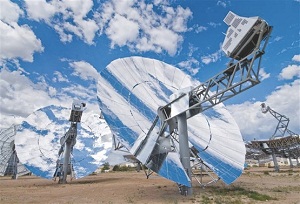Arizona's Southwest Solar marketing solar dishes for industrial heat
 Southwest Solar announced this week that it’s developing a new application for its solar dish technology that will supply solar thermal heat and steam for industrial use.
Southwest Solar announced this week that it’s developing a new application for its solar dish technology that will supply solar thermal heat and steam for industrial use.
The company has developed its solar dish in three different applications—steam-powered turbine engines for energy production, hot water and thermal energy and now simple heat.
“This is, by far, the least complicated application,” said Southwest Solar CEO Brad Forst. “To take this step and to use it as a heat source really is simplest use for the technology.”
The company’s many industrial engineers have spent a lot of time developing Southwest’s solar dish technology with different energy generation techniques. But not taking that extra step of turning heat into energy could be one of the company’s best ideas yet.
Industrial heat accounts for a very large share of global energy use, Forst said. By supplying the heat directly, Southwest’s solar dishes can help businesses skip steps and save. The dishes don’t have to convert heat to energy, which would then be converted back to heat for industrial use.
“It wouldn’t ever scale to a residential level,” Forst said. “But it’s very applicable at the industrial level.”
Southwest launched in 2007 and was created by University of Phoenix owner, John Sperling.
“He puts his money into businesses he thinks are socially responsible,” Forst said.
Most of the company’s early years were spent in development. But it did sell its first steam-powered turbine system in China last year and plans to deploy it in 2013.
The company’s signature on the solar industry is its solar dish design it uses, rather than the reflective troughs generally used in Concentrated Solar Power applications.
“There is a lot of land required for those parabolic troughs,” Forst said. “And a lot of heat is lost. Those aren’t very efficient systems.”



